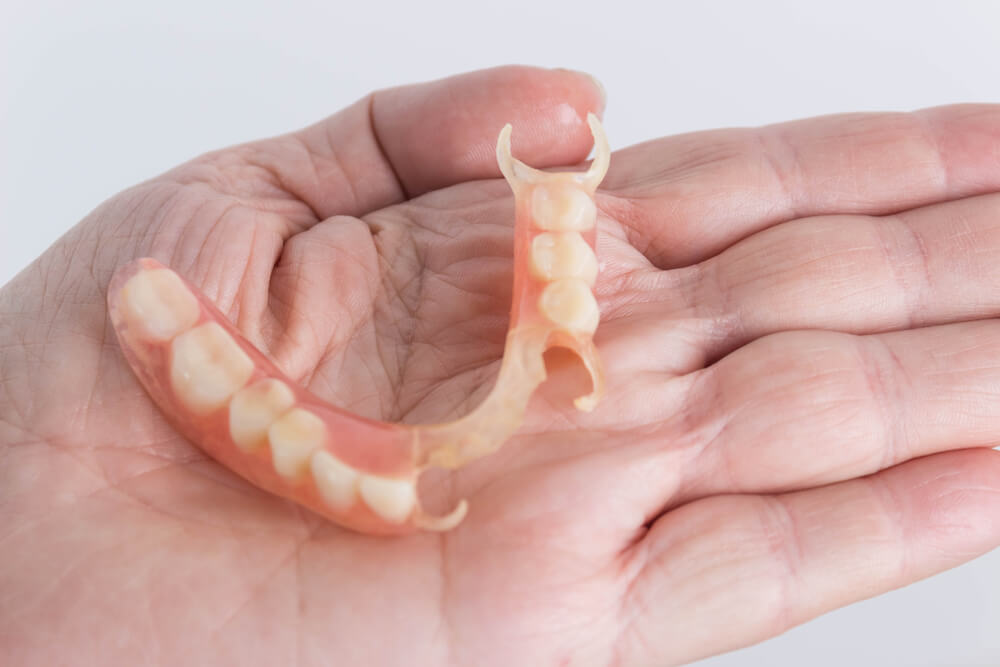Living with missing teeth can be challenging. It impacts our eating and speaking and can cause problems with our remaining teeth. Many people believe dentures are for those who are missing an entire arch of teeth or more. However, some dentures can be used to replace only a few missing teeth. These dentures tend to be more secure than full dentures and can help prevent the advance of dental health issues caused by missing teeth. Here at Dentistry Done Right, we’re dedicated to ensuring that we help preserve your smile and oral health for a lifetime.
Did you know?
Partial dentures require gentle care and frequent cleaning. Once you get your new partial dentures, you’ll need to:
- Keep them moist at all times by soaking them in a denture solution when not in use
- Gently brush your dentures daily using a soft-bristled tooth brush
- Be careful not to drop your partial dentures, as they may break
- Avoid exposing your partial to hot temperatures that could cause warping
Partial Dentures And How They Benefit Oral Health
When we lose our teeth, we can significantly impact our day-to-day life. We may not be able to eat as quickly as we could before. Our speech and our willingness to smile openly can be impacted. More importantly, without the support of these teeth, our remaining teeth may shit out of position and experience additional wear and tear.
Partial dentures are removable and are affixed by one of two types of attachment:
- Metal Clasps – These clasps fit around the base of the remaining teeth, securing the partial denture in place. The metal used in their construction can cause additional wear and tear on our natural teeth. As a result, the remaining teeth are often capped to protect them.
- Precision Attachments – These attachments are nearly invisible, unlike metal clasps. This makes them a frequent choice for patients worried about their appearance. They use a special male/female attachment setup, similar to snap buttons. The female housing is attached to the natural teeth, with the male on the partial dentures. This allows them to be easily snapped into place and removed for cleaning.
The first step to receiving partial dentures is a fitting. During this visit, your current oral health will be carefully assessed. Dr. Rhee will determine if crowns will be necessary for your remaining teeth. They will then take a mold using wax or plastic to get the right shape for your dentures and choose colors that closely match your natural teeth. The impressions and color choices will be sent to a dental lab for manufacture.
When you first receive your partial dentures, you may experience some strange sensations. They may feel loose or heavy, and you may produce excess saliva. However, once you’ve adjusted to them, these experiences should pass. Further, they should be comfortable to wear and fit well. If they feel too loose or tight or if your gums continue to be sore while wearing them, call for an appointment for a refitting.
Frequently Asked Questions
Am I a candidate for partial dentures?
You may be a candidate for partial dentures if you have one or more missing teeth, and the space they once filled is surrounded by other teeth or permanent restorations. To find out more about whether partial dentures are right for you, schedule a consultation with your dentist.
What should I expect when being fit for partial dentures?
If you decide to get a partial denture, you’ll need to visit your dentist to have metal clasps attached to your surrounding teeth and an impression made of the area your partial will fill. The impression will be sent to a dental lab, where a technician will fabricate a custom denture that includes a gum-colored base that will fit securely over your gums. A metal framework will be used to attach your new partial to the clasps on your natural teeth to ensure a secure fit.
Will I need to follow any special oral health instructions after receiving my partials?
Yes. Good oral health is still important – even if you have a few missing teeth. In addition to caring for your new dental prosthetic, you’ll also need to brush your gums and tongue twice daily to stimulate circulation and remove bacteria that could cause gum disease. Continue seeing your dentist twice yearly for exams and cleanings, and be sure to bring your partial dentures along to each visit. After a few years, you may find that your partial needs to be rebased to better fit the changes to the bone structure in your mouth.
Get Your Partial Dentures At Dentistry Done Right
Getting partial dentures can go a long way toward preserving your oral health. The longer you go with gaps in your teeth, the greater the consequences to your oral health. Your remaining teeth will experience additional wear and tear and may move out of place over time. Contact our office to get a full consultation about partial dentures. You and Dr. Rhee will develop a treatment plan to address your concerns and restore your smile.

